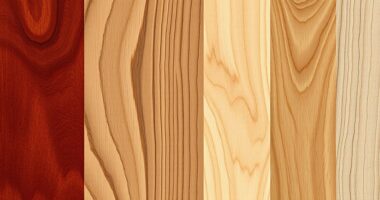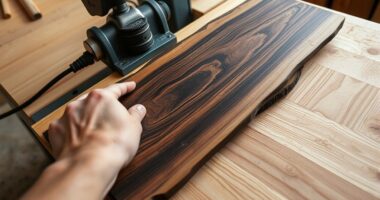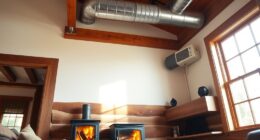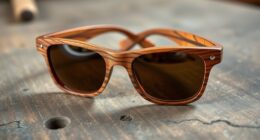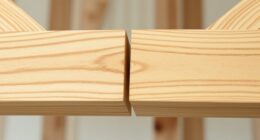For your outdoor projects, choose woods that offer durability and resistance to weather. Teak and Western Red Cedar top the list, thanks to their natural oils that fend off moisture, decay, and pests. Hardwoods like White Oak and Black Locust provide strength and long-lasting performance, while sustainably sourced options like Cypress and Bamboo add eco-friendly benefits. If you want a wood that combines beauty, resilience, and sustainability, exploring these choices will help you make the best decision.
Key Takeaways
- Durability and resistance to decay, moisture, pests, and weathering are essential for outdoor wood longevity.
- Woods like teak, Western Red cedar, and red cedar naturally resist rot and insects, reducing maintenance needs.
- Mechanical strength and stability are important for supporting heavy loads and maintaining shape over time.
- Sustainable options such as black locust, bamboo, and FSC-certified cedar support eco-friendly outdoor projects.
- Aesthetic qualities like grain, color, and natural beauty enhance visual appeal with minimal finishing required.
Teak
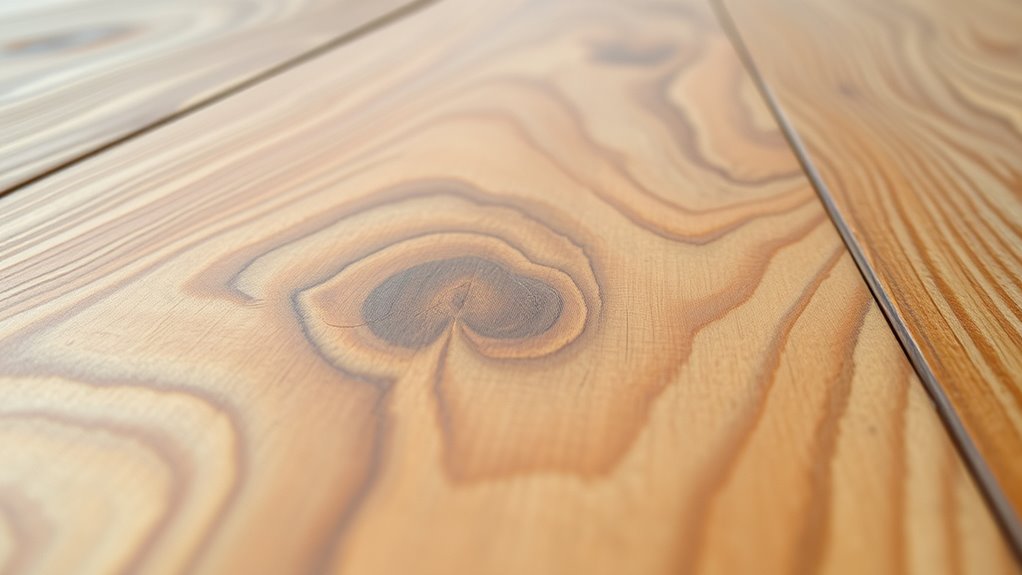
Teak is renowned for its exceptional outdoor durability, thanks to its high natural oil content that actively repels water and resists moisture-related damage. These oils, along with natural waxes, protect the wood against moisture penetration and fungal decay. Its silica content further strengthens its structure against moisture-related issues. You’ll find that teak resists warping and cracking, even in humid conditions, making it ideal for outdoor use. Its density, about 40 pounds per cubic foot when dry, ensures stability. Plus, it doesn’t react with metals, preventing corrosion of fasteners, and requires minimal upkeep to maintain its resilience and appearance over time. Additionally, the presence of natural preservatives in teak enhances its ability to withstand outdoor elements without extensive chemical treatments. Proper sealing and regular maintenance can further prolong its lifespan and appearance, especially when proper sealing techniques are employed to enhance its protective qualities. Regular application of sealants and oils helps preserve its natural luster and extends the longevity of outdoor projects.
Western Red Cedar
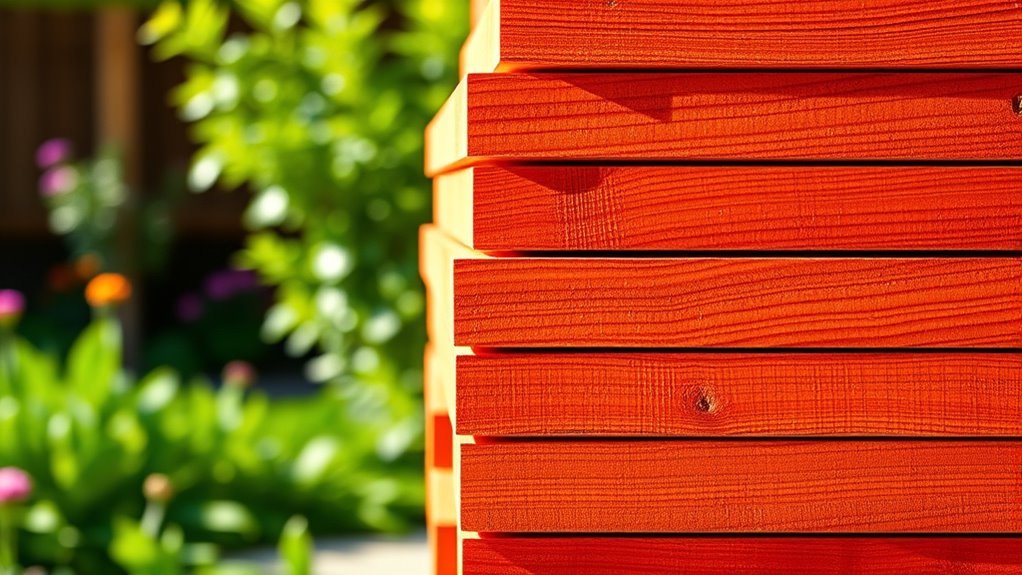
Western Red Cedar is a popular choice for outdoor projects because of its natural resistance to decay and insect damage. Its unique oils and compounds help it withstand harsh weather conditions without the need for chemical treatments. Supports sustainable forestry and its renewable nature make it an eco-friendly option for environmentally conscious builders. You’ll appreciate its attractive reddish-brown color, which enhances the look of any outdoor space. The wood is lightweight and easy to work with, making installation quicker and less labor-intensive. It offers excellent durability, ensuring your projects last for decades. Its low shrinkage and warping resistance mean it stays stable over time, even in changing moisture levels. Plus, Western Red Cedar’s natural oils act as pest deterrents, adding to its longevity. Weather resistance is one of the key benefits that makes this wood ideal for outdoor use. Whether for cladding, fencing, or decking, this wood combines beauty, strength, and sustainability for outdoor use.
White Oak
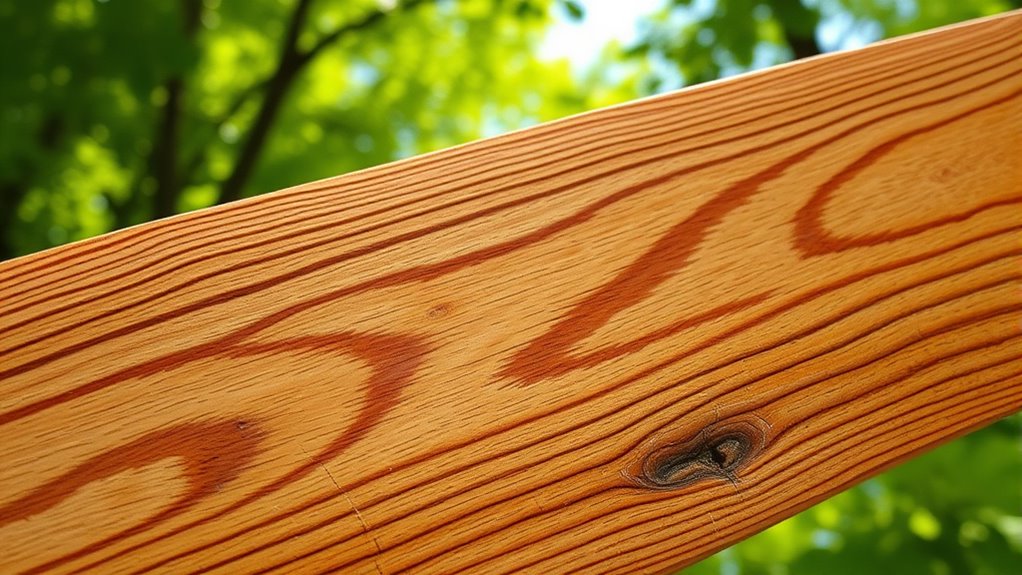
White Oak is a highly durable and water-resistant hardwood that’s well-suited for outdoor projects. Its heartwood ranges from light tan to pale brown, with nearly white sapwood and straight, fine-grain patterns. Thanks to its high density and a Janka hardness of 1,360 pounds, it offers excellent impact resistance and structural strength.
Its natural waterproofing properties, including tyloses plugging its pores, make it resistant to decay, rot, and insect damage. White Oak can withstand harsh weather conditions, making it ideal for decking, furniture, pergolas, and other outdoor structures.
Despite its density, it’s easy to work with and accepts stains and finishes well, enhancing its classic appearance. Its low shrinkage rate ensures stability, allowing your outdoor projects to last for decades with proper maintenance.
Redwood

Redwood stands out as an excellent choice for outdoor projects thanks to its natural resistance to decay, pests, and weathering. It can withstand sun, rain, and snow without warping or splintering, which helps it keep its structural integrity and beauty longer. Its moisture resistance prevents rot and insect damage, reducing maintenance needs. Redwood’s ability to resist common outdoor wood problems without chemical treatments makes it particularly appealing. When selecting redwood, choosing the right grade is important—heartwood grades offer better durability, while sapwood grades are less resistant. Its rich color and fine grain make it ideal for visible structures like decks, furniture, and siding. Plus, redwood is sustainably harvested, and its longevity means fewer replacements, making it a smart, eco-friendly outdoor solution. Additionally, understanding the wood’s natural properties helps in selecting the best type for specific outdoor applications. Considering its environmental benefits can also influence sustainable choices when planning outdoor projects. Being aware of cybersecurity threats related to online purchasing of wood and materials can help protect your investments and personal information during the project planning process. A thorough knowledge of wood treatment methods can also enhance the durability and lifespan of your outdoor wood projects. Moreover, proper maintenance techniques can significantly extend the life of redwood in outdoor settings.
Spanish Cedar
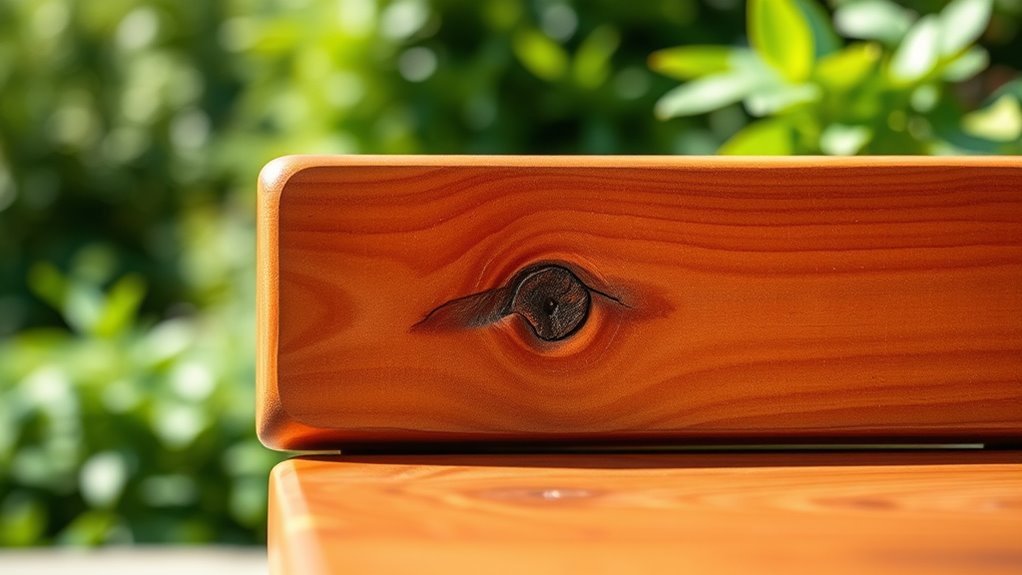
Spanish cedar is highly valued for outdoor projects because of its excellent durability and resistance to decay and insects. It’s moderately durable against rot and highly resistant to termites and other wood-boring insects, making it ideal for outdoor use. It weathers well and can withstand harsh conditions, especially when sourced from older, slower-growing trees that are more durable. Additionally, it can still be attacked by Powderpost beetles. Its heartwood ranges from light pinkish to reddish-brown, darkening over time, with a straight or slightly interlocked grain. The medium texture and lightweight nature make it easy to work with, though it’s soft enough to require careful handling. Its cedar-like aroma adds a unique touch, making it popular for outdoor furniture, window frames, and decorative projects. Proper sealing and maintenance can further enhance durability, ensuring your outdoor investments last longer. Using proper sealing techniques can also help protect the wood from moisture and UV damage, extending its lifespan even further. Regular treatment with wood preservative can further safeguard Spanish cedar from environmental elements and pests. The resistance to insects makes it particularly suitable for outdoor settings where pest exposure is a concern.
Cypress
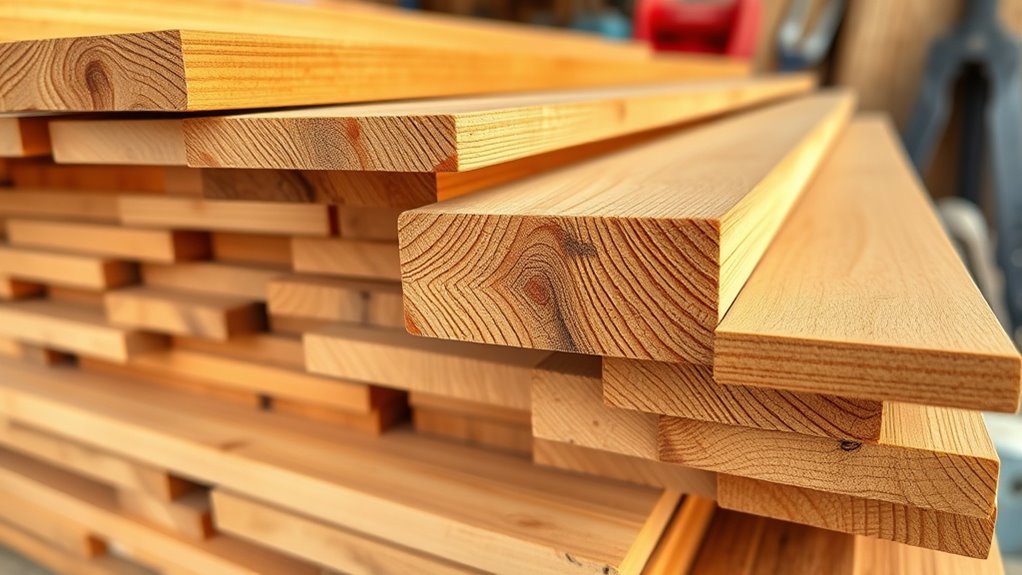
Ever wondered why cypress wood has become a popular choice for outdoor projects? Its high durability and stability make it ideal for withstanding the elements, so your furniture and structures last longer. Cypress has a smooth texture and straight grain, making it easy to cut, shape, and finish. Its high oil content acts as a natural preservative, resisting decay and insects without chemical treatments. Despite being strong, cypress is lightweight, simplifying transportation and installation. It’s perfect for outdoor furniture, decks, pergolas, and decorative elements, thanks to its weather resistance and aesthetic appeal. Plus, it’s environmentally friendly—growing rapidly and requiring no chemicals—making it a sustainable, cost-effective option that offers long-lasting performance with minimal maintenance. Regularly checking the condition of the wood can help maintain its integrity over time, especially considering its natural drainage and ventilation properties.
Black Locust
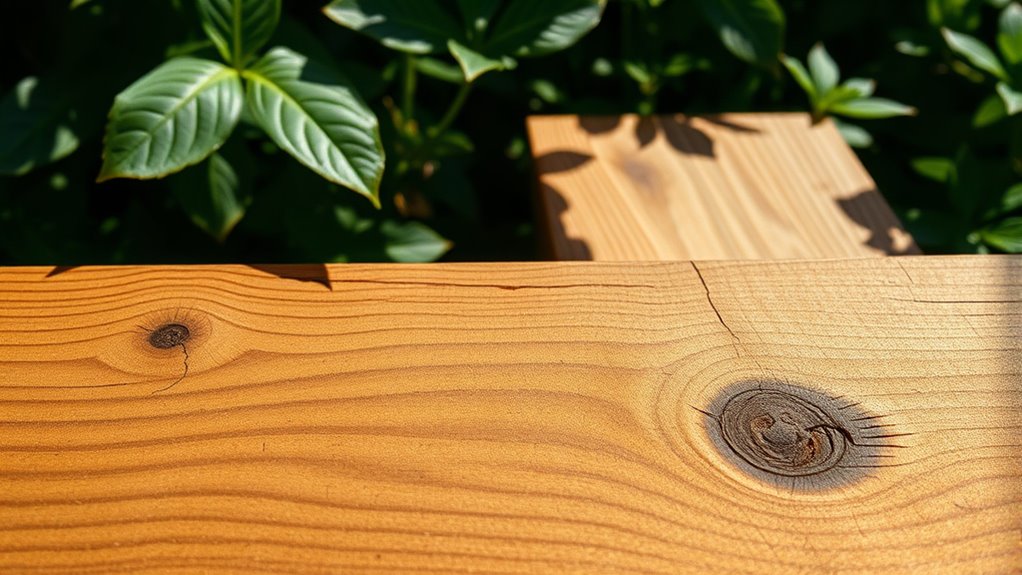
Black Locust stands out as one of the most durable and rot-resistant woods suitable for outdoor use. Its natural resistance to decay and insects means you won’t need chemical treatments or frequent maintenance. With a lifespan of up to 100 years, it’s ideal for fence posts, decking, and outdoor furniture that withstands moisture and weathering. Properly managing IRA withdrawal strategies can further ensure your outdoor projects are financially sustainable over the long term. Black Locust’s high density and toughness make it resistant to wear, cracking, and warping, supporting heavy loads and long-term use. It’s also remarkably strong and stiff, comparable to hickory, and can be worked carefully for detailed projects. Additionally, its ability to fix nitrogen in the soil helps improve soil health around your outdoor structures. Its rapid growth rate and capacity to support ecosystem health make it an environmentally beneficial choice. Growing rapidly and fixing nitrogen in the soil, it’s environmentally beneficial. Its rich, golden hue darkens naturally over time, adding visual appeal to outdoor structures. Moreover, its rapid growth and ability to enrich soil quality make it a sustainable choice for long-term forestry or landscaping projects.
Red Cedar (Western Red Cedar)
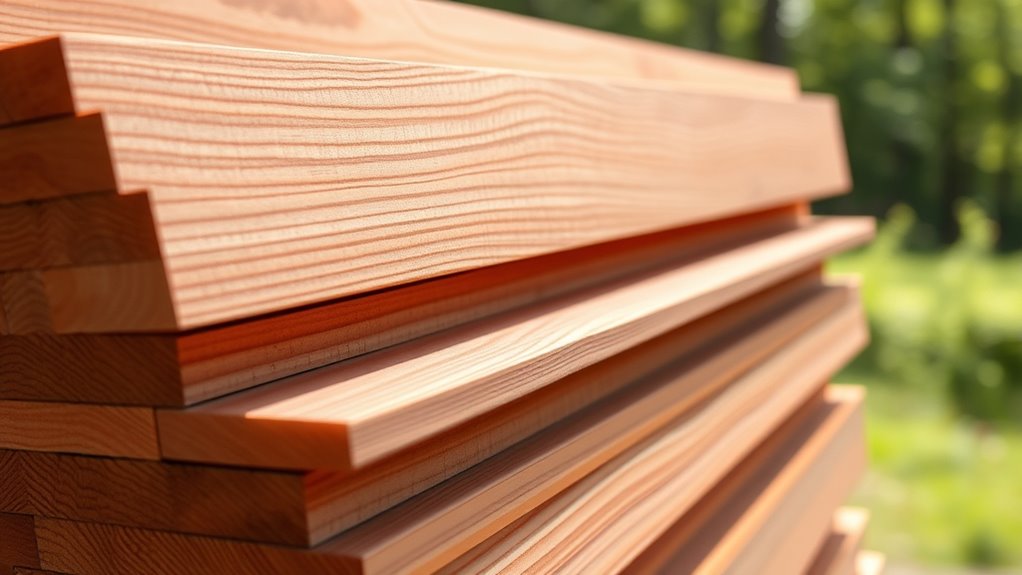
Western Red Cedar stands out as an outstanding choice for outdoor projects thanks to its natural durability and resistance to decay. Its unique chemical compounds and natural oils act as pest deterrents, eliminating the need for chemical treatments.
Western Red Cedar’s natural durability and pest resistance make it ideal for long-lasting outdoor projects.
With remarkable fungicidal properties lasting over 100 years, it’s highly durable for exterior use. Its superb dimensional stability minimizes warping, cupping, and twisting, even with moisture changes, making it ideal for fencing, siding, and garden furniture.
Lightweight and easy to work with, it cuts, shapes, and finishes effortlessly, speeding up construction. The wood’s rich, reddish-brown color and attractive grain add warmth and character to any project.
Plus, its sustainability and natural resistance reduce maintenance needs, making it a practical, eco-friendly option for long-lasting outdoor applications.
Sustainably Sourced Options
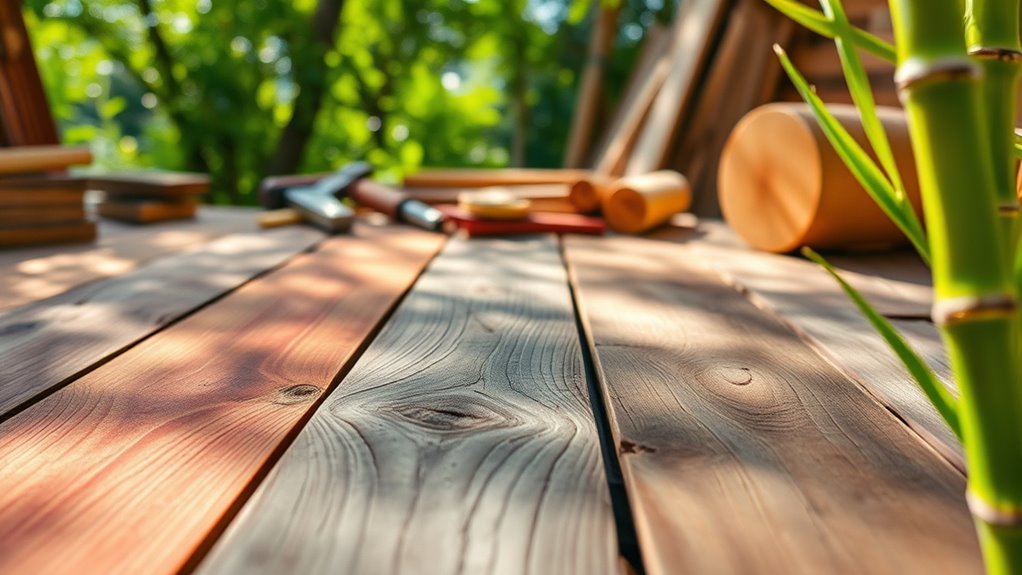
Choosing sustainably sourced wood options guarantees your outdoor projects are eco-friendly and durable. Woods like acacia, redwood, cypress, and teak are excellent choices because they naturally resist rot, insects, and moisture, reducing the need for chemical treatments.
Acacia, with its high oil content, repels pests, while redwood and cypress thrive in outdoor conditions without degrading quickly. Teak offers exceptional durability and moisture resistance, making it ideal for furniture.
Bamboo is also a sustainable option, thanks to its rapid growth and versatility, although it’s more common for decor and small projects.
When selecting these woods, look for certifications like FSC to ensure responsible harvesting. By choosing sustainable options, you help protect ecosystems while creating long-lasting, beautiful outdoor structures.
Frequently Asked Questions
How Does Wood Treatment Affect Outdoor Durability and Appearance?
You’ll notice that wood treatment markedly boosts outdoor durability by reducing moisture absorption and increasing decay resistance. It also influences appearance, causing color changes like browning or greying over time due to weather and UV exposure.
Chemical treatments add insect and fungi resistance but raise environmental concerns. Thermal treatments are eco-friendly, enhancing stability without chemicals.
Can Reclaimed or Recycled Wood Be Suitable for Outdoor Use?
Reclaimed or recycled wood can be suitable for outdoor use if you carefully select and treat it. You should inspect it thoroughly for pests, nails, or contaminants, and apply proper sealing or finishes to protect against weather.
Dense, decay-resistant species like tropical hardwoods often perform well outdoors. Regular maintenance will help preserve its appearance and durability.
Making reclaimed wood a sustainable and charming choice for outdoor projects can help it stand the test of time.
What Maintenance Is Required for Different Outdoor Wood Types?
You need to clean, seal, and protect your outdoor wood regularly. Western red cedar benefits from gentle cleaning and UV-protective finishes.
Redwood needs sealing to preserve its color. Cypress requires minimal maintenance but can be sealed for extra protection.
Ipe demands little care but may be sealed to keep its color.
Consistent cleaning, sealing, and protective treatments guarantee your wood stays beautiful and long-lasting in outdoor settings.
How Do Climate Variations Influence the Lifespan of Outdoor Woods?
Climate variations substantially impact your outdoor wood’s lifespan. In humid and rainy areas, moisture causes rot and mold, so you need to choose rot-resistant woods like cedar or redwood.
Extreme temperatures make the wood expand or contract, risking cracks. Sun exposure can fade and dry out your wood, so sealing and regular maintenance are essential.
Properly selecting and caring for your wood based on climate helps extend its durability and beauty over time.
Are There Eco-Friendly Finishes That Enhance Outdoor Wood Longevity?
You’re wondering if eco-friendly finishes can boost outdoor wood’s lifespan. The good news is, natural oil finishes like tung oil penetrate deeply, protecting against moisture and UV damage without harmful chemicals.
Non-toxic products like Eco Wood Treatment also offer lifetime protection, prevent fungal decay, and develop a weathered look quickly. These options are safe for the environment, easy to apply, and require minimal maintenance, helping your wood stay durable longer.
Conclusion
Choosing the right wood for your outdoor project can feel overwhelming, but with the right options, you’ll create something that lasts a lifetime—no, even longer. From the durability of teak to the beauty of Western Red Cedar, each choice offers unique benefits. Remember, selecting sustainable wood isn’t just good for the environment; it’s a decision that guarantees your masterpiece stands the test of time, weather, and wear—truly, it’s an investment in a future that’s built to last forever.


